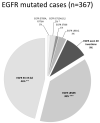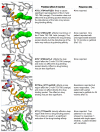EGFR exon 20 insertion mutations in lung adenocarcinomas: prevalence, molecular heterogeneity, and clinicopathologic characteristics
- PMID: 23371856
- PMCID: PMC3714231
- DOI: 10.1158/1535-7163.MCT-12-0620
EGFR exon 20 insertion mutations in lung adenocarcinomas: prevalence, molecular heterogeneity, and clinicopathologic characteristics
Abstract
In contrast to other primary epidermal growth factor receptor (EGFR) mutations in lung adenocarcinomas, insertions in exon 20 of EGFR have been generally associated with resistance to EGFR-tyrosine kinase inhibitors. Their molecular spectrum, clinicopathologic characteristics, and prevalence are not well established. Tumors harboring EGFR exon 20 insertions were identified through an algorithmic screen of 1,500 lung adenocarcinomas. Cases were first tested for common mutations in EGFR (exons 19 and 21) and KRAS (exon 2) and, if negative, further analyzed for EGFR exon 20 insertions. All samples underwent extended genotyping for other driver mutations in EGFR, KRAS, BRAF, ERBB2/HER2, NRAS, PIK3CA, MEK1, and AKT by mass spectrometry; a subset was evaluated for ALK rearrangements. We identified 33 EGFR exon 20 insertion cases [2.2%, 95% confidence interval (CI), 1.6-3.1], all mutually exclusive with mutations in the other genes tested (except PIK3CA). They were more common among never-smokers (P < 0.0001). There was no association with age, sex, race, or stage. Morphologically, tumors were similar to those with common EGFR mutations but with frequent solid histology. Insertions were highly variable in position and size, ranging from 3 to 12 bp, resulting in 13 different insertions, which, by molecular modeling, are predicted to have potentially different effects on erlotinib binding. EGFR exon 20 insertion testing identifies a distinct subset of lung adenocarcinomas, accounting for at least 9% of all EGFR-mutated cases, representing the third most common type of EGFR mutation after exon 19 deletions and L858R. Insertions are structurally heterogeneous with potential implications for response to EGFR inhibitors.
©2012 AACR.
Figures



Comment in
-
EGFR exon 20 insertion A763-Y764insFQEA and response to erlotinib--Letter.Mol Cancer Ther. 2013 Nov;12(11):2614-5. doi: 10.1158/1535-7163.MCT-13-0192. Epub 2013 Aug 22. Mol Cancer Ther. 2013. PMID: 23969006 No abstract available.
References
-
- Paez JG, Janne PA, Lee JC, Tracy S, Greulich H, Gabriel S, et al. EGFR mutations in lung cancer: correlation with clinical response to gefitinib therapy. Science. 2004;304:1497–500. - PubMed
-
- Lynch TJ, Bell DW, Sordella R, Gurubhagavatula S, Okimoto RA, Brannigan BW, et al. Activating mutations in the epidermal growth factor receptor underlying responsiveness of non-small-cell lung cancer to gefitinib. N Engl J Med. 2004;350:2129–39. - PubMed
-
- Huang SF, Liu HP, Li LH, Ku YC, Fu YN, Tsai HY, et al. High frequency of epidermal growth factor receptor mutations with complex patterns in non-small cell lung cancers related to gefitinib responsiveness in Taiwan. Clin Cancer Res. 2004;10:8195–203. - PubMed
-
- Kosaka T, Yatabe Y, Endoh H, Kuwano H, Takahashi T, Mitsudomi T. Mutations of the epidermal growth factor receptor gene in lung cancer: biological and clinical implications. Cancer Res. 2004;64:8919–23. - PubMed
Publication types
MeSH terms
Substances
Grants and funding
LinkOut - more resources
Full Text Sources
Other Literature Sources
Medical
Molecular Biology Databases
Research Materials
Miscellaneous

